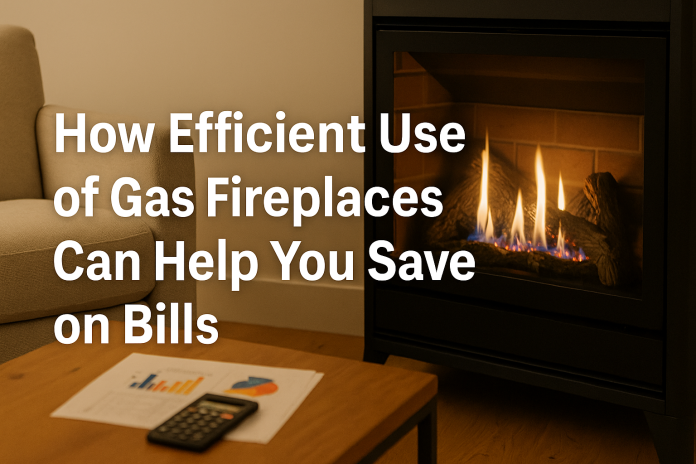Heating your home can be one of the most significant winter expenses. With the right approach and a reliable gas fireplace at the centre of your system, you can enjoy consistent warmth and substantial savings. This blog offers guidance on selecting the best appliances, setting up efficient heating zones, and maintaining your system in optimal condition.
Understanding Zone Heating
Zone heating directs warmth only where you need it, cutting wasted energy. A freestanding gas fireplace can serve as the primary heater for a living area, while other zones remain on or off at low settings. Each zone has its own thermostat and control valve, allowing you to drop temperatures in guest rooms, hallways or storage spaces. Throughout a whole winter, precise control can reduce overall gas use by up to 30 per cent, resulting in lower bills.
How Thermostats Help
Modern thermostats respond quickly to changes in temperature. Install one in each key zone—living room, main bedroom and home office—to keep conditions stable. When the thermostat senses a drop below your set point, it signals the freestanding gas fireplace to supply heat. On milder days, lower the setting to save fuel. Programmable models let you set different temperatures for mornings, evenings and overnight, so you begin the day cosy and don’t waste energy while asleep.
Choosing the Right Fireplace Model
Select a fireplace that fits your home’s size. A freestanding gas fireplace rated above 75 per cent efficiency will convert most of the gas into heat rather than exhaust. Features such as adjustable flame height and a built-in blower fan boost performance on colder days. For rooms without safe ventilation options, a freestanding electric fireplace offers a simple alternative—it requires no flue but still provides gentle warmth. Running costs for electric models are usually lower on mild days and may help you rely less on gas overall.
Installation and the Role of a Fireplace Flue Kit
A correctly installed fireplace flue kit is vital. The kit comprises insulated pipes, seals and caps designed to suit your fireplace’s output. Proper assembly prevents warm air from escaping up the chimney and stops cold air from drafting in. Even small gaps around flue joints force your heater to work harder, resulting in increased gas use. Hiring a licensed technician to fit the fireplace flue kit ensures all seals are airtight and compliant with safety standards.
Maintenance for Long-Term Savings
A well-maintained fireplace stays efficient. Perform these simple tasks:
- Monthly: Wipe down the glass front to remove any residue so the heat radiates freely.
- Quarterly: Vacuum around the blower fan intake to maintain smooth airflow.
- Annually: Book a professional service. Technicians will clean the burner jets, inspect the pilot assembly, and verify that the fireplace flue kit remains in good working order. A single service visit can restore up to 15 per cent of lost efficiency, meaning your system uses less gas to produce the same amount of heat.
Switch Between Heat Sources to Balance Your Budget
Even the best gas fireplaces work hardest on colder nights. On warmer evenings or when hosting outdoors, consider an outdoor wood fireplace. It creates a cosy atmosphere on your patio while saving gas usage indoors. Use dry, seasoned timber and position the fire at a safe distance from structures.
Indoors, a freestanding electric fireplace can handle spot heating for a bedroom or study room. These units plug into a standard power outlet, avoid flue requirements and cost only a few cents per hour on low settings. By rotating between gas and electric heating, you balance your bills and maintain comfort.
Smart Controls and Daily Practices
Adopt small habits that yield significant savings:
- Close doors to unused rooms and shut windows when the fireplace runs.
- Draw curtains at dusk to trap heat inside.
- Use draft stoppers under doorways to block cold air from entering.
- Program your thermostat to lower temperatures when you leave for work and raise them an hour before you return.
Link your freestanding gas fireplace to a smart thermostat or home management system for remote control. Turn down the heat while you run errands, and switch it back on from your phone before you arrive home.
A Practical Example of Savings:
Consider a household that spends $1,200 on gas heating over winter:
- By installing zone controls around a freestanding gas fireplace, they reduce overall gas use by 25 per cent, saving $300.
- Adding an outdoor wood fireplace and a freestanding electric fireplace for mild evenings yields another $100 off the bill.
- Annual maintenance and the correct installation of a fireplace flue kit contribute a further 10 per cent improvement, saving $120.
Altogether, this household pays just $680 instead of $1,200—over a $500 saving.
Safety and Compliance
Always follow local regulations when installing or changing heating systems. Ensure your fireplace flue kit and gas lines comply with Australian standards. Have gas fittings pressure tested after service visits and check carbon monoxide detectors regularly. A safe, well-inspected appliance not only protects your family but runs more efficiently.
Final Thoughts
Maximising savings on heating bills is achievable with a plan. Use zone controls and thermostats to limit heat to occupied areas. Select an efficient freestanding gas fireplace, install a high-quality fireplace flue kit, and schedule annual maintenance.
On mild or social evenings, switch to an outdoor wood fireplace or a freestanding electric fireplace. Blending smart controls, following simple daily practices, and safe operation will keep your home warm and bills low all winter long.


